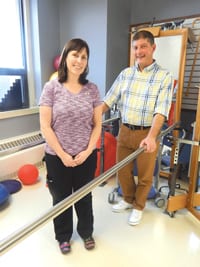Functional Assets – Rehab Centers Help Seniors Limit Their Limitations
Only a few generations ago, many people who had strokes did not survive, while seniors who had respiratory problems, broke a hip, had an amputation, or suffered from other serious health conditions never regained their strength or functionality.
But, thanks to medical advances, people are not only living longer, many can return home or to an assisted-living facility if they receive rehabilitation therapy after being released from an acute-care hospital.
“It’s extremely rewarding to see someone with a functional problem tell us, ‘I never thought I could do that again,’” said John Hunt, chief executive officer of HealthSouth Rehabilitation Hospital of Western Massachusetts in Ludlow, noting that the majority of its patients are 65 or older. “We’re not making people perfect, but we are increasing their function and helping them compensate for their new disability.”
That’s especially important because today’s seniors are more active than people in previous generations, want to remain independent, and have the ability to continue activities they enjoy.
In addition, hospital stays are often limited to days instead of weeks, and although this helps prevent elders from getting weak from lying in bed for long periods of time, many have more than one health condition and need care immediately after they are released.
“Most people are eager to get home as soon as possible after a hospital stay,” said Heidi Hevey, regional director of admissions and marketing for Wingate Healthcare, which has 24 facilities in three states. “But going directly home might not be the best choice compared to spending some time in a skilled-nursing facility where the person can rebuild their strength and get help with any new limitations. Our job is to give them whatever is medically necessary to get them back to the highest level of functionality they can attain.”
Jack Jury, lead physical therapist at Weldon Rehabilitation Hospital in Springfield, said education is also important so people understand why their hospitalization occurred, how they can prevent a return visit, what they need to know about their health conditions, and the medications prescribed for them.
“We put a big focus on looking at the patient as a whole and do our best to incorporate their wants and needs,” he said. “But we also make sure the person understands everything about their health. As people live longer, the need for comprehensive education has increased.”
The length of time a patient spends in a rehabilitation facility depends on their health; ability to engage in physical, occupational, and speech therapy; how quickly they progress; and other factors. But insurance typically covers the cost of therapy needed for recovery, which can take place in stages that may begin at an acute inpatient rehabilitation hospital, progress to therapy in a sub-acute setting, and be followed with outpatient or home care.
For this issue and its focus on the aging of America, HCN looks at the types of services seniors receive today, the conditions that cause them to need help, and how rehabilitation extends the quality of their life with as few limitations as possible.
Treatment Variables
Rehabilitation can take place in a variety of settings, and physicians make referrals based on individual needs, although ultimately the decision where someone receives therapy is made by the patient or their family.
Rehab hospitals offer the highest level of care, but individuals must meet specific qualifications to be accepted as a patient. They include a referral by a physician; a need for 24-hour rehabilitation that can’t be provided in a less-intensive setting such as a nursing home or assisted-living facility; the need for two or more types of therapy, including physical, occupational, or speech/language; and the ability to participate in a minimum of three hours of therapy a day, five days a week.
A physician is present in these hospitals 24 hours a day, and the typical stay is about two weeks. Patients often need more therapy, but at that point they can be transferred to a sub-acute care center or receive outpatient therapy or home care.
Stroke accounts for the majority of admissions at local rehabilitation hospitals, and these patients often need assistance regaining mobility, cognition, speech, and swallowing.
“Recovery is unpredictable and variable and can occur over the course of a year or two,” Jury noted, adding that most of that therapy is delivered in outpatient care settings.
Weldon was recently awarded accreditation by CARF International for its inpatient rehabilitation program for adults, stroke specialty program, and program for children and adolescents. The certification is good for three years, and it is the eighth consecutive time the hospital has received the accreditation.
Meanwhile, HealthSouth has received disease-specific care certification from the Joint Commission for strokes, brain injuries, and pulmonary rehabilitation, in addition to the standard Joint Commission accreditation.
In 2013, its aging facilities were replaced with a $23 million hospital, and every room is private and spacious, which allows patients to have some therapy there if they need or want that option.
Thirty years ago, Hunt said, people were kept in the hospital for weeks after a stroke, but today they are discharged and moved to a rehabilitation facility after a few days, and the goal is to get them moving and back to normal as quickly as possible.
“We start discharge planning as soon as the person comes here, and we let them know the estimated length of their stay,” he noted, adding that 80{06cf2b9696b159f874511d23dbc893eb1ac83014175ed30550cfff22781411e5} of patients at HealthSouth are able to return home, although they may need additional therapy.
For example, an 85-year-old who has had a stroke may have lost the use of his or her right arm. “We help the person gain strength, improve their function, and learn to use the arm in a different way than before the stroke occurred,” Hunt explained. “No two patients are the same, so we don’t have a cookie-cutter approach to treatment.”
In addition to stroke, rehab hospitals see people with brain or spinal-cord injuries, disorders such as Parkinson’s disease and multiple sclerosis, amputations, respiratory conditions, diabetes, infections, and a multitude of other health problems.
Hunt told HCN that many people don’t know that seniors who are living a marginal existence due to functional deficits may be eligible for admission to a rehab hospital, which can improve the quality of their life as well as help their caregivers.
However, discharge planning to ensure that every patient gets the help or care they need is critical. “But it can be challenging,” said Cheryl Moriarty, lead occupational therapist at Weldon Rehabilitation Hospital.
She cited a few examples that make care planning complex: the patient’s spouse may have been caring for them at home but can no longer do so because of new medical complications; patients may need assistance that is difficult for family members to coordinate; and assistance from resources in the community may also need to be arranged.
In addition, family members must receive education about their loved one before a discharge, which includes changes that may be needed at home, such as adding a ramp or moving a bedroom from a second floor to a first floor.
Jury said Weldon sees many patients who have had amputations due to uncontrolled diabetes or vascular disease. They haven’t healed enough to be fitted for a prosthesis and need to learn how to care for their extremity, use a wheelchair or walker, shower, get in and of bed, use the bathroom, and be able to accomplish other tasks of daily living.
The loss of a limb can be difficult emotionally, so Weldon schedules peer visits with amputees for people who have had similar amputations and are about the same age and gender as the patient.
Tamilyn Levin, chief operating office for Wingate Healthcare, says its admission criteria is different than a rehabilitation hospital, and the patient’s length of stay depends on what they need and how quickly they progress.
She told HCN that every Wingate has a gym and team of therapists and nurses. Patients at their facilities can also receive assistance with tasks of daily living, such as getting dressed, if and when it is needed.
Every patient is seen by a physician during their stay, and every Wingate has a trainer whose job is to keep pace with changes in healthcare and make sure employees are kept informed about best practices.
Hevey noted that the East Longmeadow and South Hadley facilities have pavilion suites for patients who need short-term rehabilitation.
“Most of the rooms are private, and there is a separate entrance for this section of each building,” she said, noting that stays are typically two weeks or less and patients receive one to four hours of therapy a day, depending on their needs and how much they can tolerate.
“We treat a wide range of conditions that range from wound care to infections to respiratory problems, and also see patients who are weak and deconditioned from the flu or chemotherapy,” she continued. “Our goal is to get them back to their prior level of functioning.”
Changing Environment
There are 76.4 million Baby Boomers alive today, and many have more than one health condition. “This is the beginning of the senior explosion, and we haven’t hit the peak yet,” Moriarty said.
Changes in healthcare are occurring rapidly, but local rehab facilities are keeping pace with the industry and will continue to do so as the demand for their services continues to grow.
“An individual program has to be created for each person that follows best practices, and because things are constantly in flux, our program has to be very dynamic, so we have an integrated approach from the time a patient is admitted,” Jury said.
Such policies and procedures are helping to make many seniors functional and independent, which represents a vast improvement over generations past.



Comments are closed.